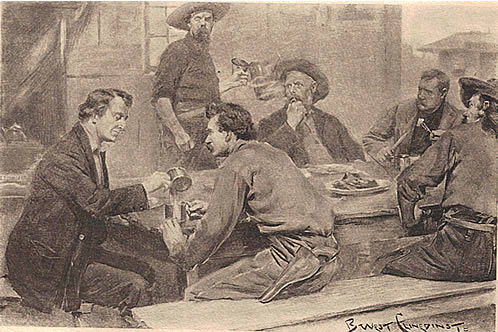
Counterculture Colophon: Grove Press, the Evergreen Review, and the Incorporation of the Avant-Garde by Loren Glass. 272 pp. Stanford University Press, 2013 [latterly republished as Rebel Publisher by Penguin, 2018].
Barney Rosset’s Grove Press published some of the most important and controversial writers of the 20th century and almost single-handedly conquered literary censorship in the USA. It did this with bravura and style. So where are the tributes, the retrospectives, the museum exhibitions? A small group of recent books and documentaries have begun to counter the strange neglect of Grove’s legacy. Loren Glass’s Counterculture Colophon, republished in paperback as Rebel Publisher, goes beyond Grove’s famed obscenity trials and explores its successful dissemination of avant-garde literature in postwar America.
In my twenties I used to find old Grove Press titles in obscure corners of Gould’s Book Arcade in Sydney’s Newtown. It was appropriate. Proprietor Bob Gould was a veteran Trotskyite and anti-war activist who’d battled Australia’s embarrassingly provincial censorship in the old days. That regime had been tougher, more narrow-minded, and more enduring than in the USA. Several times raided by the New South Wales Vice Squad, Gould had been charged in 1969 for selling posters of erotic Aubrey Beardsley drawings. After a long and ridiculous trial he was fined fifty cents.
Literary censorship effectively ended in Australia with the election of the Whitlam Government in 1972, although films were still occasionally banned. In his later years Gould would sit white-bearded and gruff behind the front counter of his chaotic, warehouse-sized bookshop. The shop was a perenial haunt for seekers of the happy oblivion of late night browsing under cold white flourescent bulbs. The size of his inventory was in absurd excess of anything manageable or sensible — a million or so disorganised books, towering in the shadowy upper-floor aisles or spilling across the dirty linoleum. In my experience he never refused to buy or exchange a pile of old books. His acquisitional habit was nothing short of a mania. “Bob wanted to have more books than anyone else on the planet,” his daughter Natalie told the Guardian in 2017. That’s why I consider it a matter of quiet pride that Gould once deemed my own book-buying habits as “pathological.” (I was at the time rummaging in a box beneath a trestle table at a huge charity book sale; Gould, evidently on his own scout, had lifted the tablecloth and squinted at me with disdain.)
Those Grove Press books I discovered in the vast depository at Gould’s were relics of the US censorship wars and its bacchanalian aftermath. Many had been printed in the US long before the Australian Government would have permitted their import. I was intrigued by the mystery of their trans-Pacific journey to Newtown. Gould sold categories of books that would never turn up elsewhere in Sydney; he’d also at some point acquired caches of books published behind the Iron Curtain by Progress Publishers (Moscow) and Seven Seas Books (Glinkastrasse, East Berlin). Most of these titles had sat on his shelves for years with pencilled prices oblivious to inflation.
1950s and 1960s Grove editions are worth collecting if only for their consistently stunning dust jackets or paperback covers designed by Roy Kuhlman, which should be as fetishized, reprinted, and monographed today as Reid Miles’s contemporaneous LP covers for Blue Note. Over the years I’ve bought a smattering. Although I can’t say I got around to reading them all, they give a representative indication of the publisher’s mission. (None of these books, you may notice, was written by a woman.) I’ve owned Grove’s unexpurgated editions of classic banned books—Henry Miller’s Tropics (1934-39), Quiet Days in Clichy (1956), and the Rosy Crucifixion trilogy (1949-59), Jean Genet’s Thief’s Journal (1949), and Frank Harris’s My Life and Loves (1922-27). I bought Breton’s Nadja (1928), Ionesco’s plays, Brecht’s Caucasian Chalk Circle (1948), André Pieyre de Mandiargues’s The Girl Beneath the Lion (1956), and Borges’s Ficciones (1956) and A Personal Anthology (1961). Grove also published young American writers, and because its imprimatur seemed a sufficient recommendation I ended up with either the very good or the very dated (and sometimes a mix of both): Robert Gover’s Here Goes Kitten (1964), Michael Rumaker’s Gringos (1967), the Tales of LeRoi Jones (1967), and the works of San Francisco Bay Area novelist Floyd Salas, whose novels Tattoo the Wicked Cross (1967) and especially What Now My Love (1969) remain on my shelves. In fact, I ended up publishing Floyd’s more recent work when I edited the journal Contrappasso. Probably the best of all my Grove bargain buys were The Olympia Reader (1965) and The Evergreen Review Reader 1957-1967 (1968), two fat anthologies derived respectively from the backlists of Maurice Girodias’s Paris-based English-language press and Grove’s wonderful house journal. The range of important international writers in each, amid the odd merely pornographic item, is extraordinary.
Loren Glass’s Countercultural Colophon draws on Max Weber’s concept of a ‘charismatic community’ to explain how Grove functioned under Barney Rosset’s leadership. Grove seems to have been less a commercial business—although it had its share of bestsellers—than a creative manifestation of Rosset’s lifelong political agitation and enthusiasms for sex and experimental art. Born to great wealth, Rosset was both an admirable class traitor and a singularly heedless businessman. He ultimately “squandered his entire fortune on Grove Press.” Bravo.
In the 1950s avant-garde art was slowly seeping into the American mainstream. Glass cites Serge Guilbaut’s research on abstract expressionist painting and how it contributed to New York’s eventual dislodgment of Paris as the international cultural centre. Grove’s literary activities down in Greenwich Village paralleled this historic shift. Glass writes:
“Grove effectively siphoned cultural capital from Paris to New York in the 1950s and 1960s, reprinting and translating authors it had acquired from Éditions de Minuit, Éditions Gallimard, Éditions du Seuil, and the Olympia Press, thereby establishing a reputation as the premier American disseminator of European avant-garde literature, especially drama. However, Grove championed the idea of an indigenous avant-garde as well, providing an early publication venue for the Beats, the New York school, and the Black Mountain school, publishing multiple scholarly studies of American jazz, adopting abstract expressionist designs for its book covers, and affirming the San Francisco Bay Area as itself a ‘cultural capital’ in a burgeoning national scene.”
According to Guilbaut, the wide acceptance of the American avant-garde in the McCarthy era relied upon the supposed political neutrality of both its intellectual champions and the aesthetics of abstract expressionism itself. Grove, however, was increasingly a vehicle for radical politics alongside its radical literature and essentially repoliticized the avant-garde in the countercultural 1960s.
Glass’s chapters, grounded in the cultural politics of the postwar world, cover a variety of Grove’s activities. They published a stunningly cosmopolitan ‘world literature’ that ranged from the novels of Beckett, Genet, and Alain Robbe-Grillet—the “triumvirate of Parisian late Modernist literary innovators”—to works that emerged from “the decolonization of the European empires and the inception of the American century.” Grove promoted leading international experimental playwrights (Beckett, Artaud, Ionesco, Arrabal) and sold countless books by “marketing the printed text in conjunction with student performances.” Meanwhile Grove’s numerous biographical and critical works celebrated and helped to cement their canon of contemporary writers.
The obscenity trials are covered in detail, and so is Grove’s support for radical politics (Latin American revolution, Black Power, and the Post-Colonial struggle) through the publication of books by Frantz Fanon, Malcolm X, Che Guevara, Fidel Castro, Régis Debray, and many others. Grove’s attempt to transform the movie business was far less successful, although its American distribution of the sexually explicit Swedish film I Am Curious (Yellow) (1967) became a controversial hit after a brief banning in 1969. Glass elaborates the important contribution Grove made to academic film culture in the USA by publishing the scripts and critical commentary on the most important foreign language art films including Hiroshima mon amour, Last Year at Marienbad, Rashomon, and The 400 Blows. Pre-VHS, these books “provided a curriculum for film studies courses during this foundational period; it also helped establish the cinematic text as a legitimate object of close reading modeled on the formal analysis of literary texts.” Glass identifies these books as the prototypes of the deluxe DVDs released by the Criterion Collection.
Although remarkably progressive in its publication of explicitly homosexual works by Genet, William S. Burroughs, and John Rechy, Grove’s support of radical emancipation was not unlimited. It published few women writers, its company structure was male-dominated, and its relentlessly libertine agenda was sometimes at odds with the contemporary feminist movement. Opposition to Grove’s “popularization of pornography” did not only come from the church and conservative groups. “By democratizing access to previously forbidden texts,” Grove had made the question of obscenity “more directly accessible to political, rather than moral or aesthetic, critique.”
Nevertheless, Rosset’s successful legal campaign to defend his right to publish the unholy trio of Lady Chatterley’s Lover, Tropic of Cancer, and The Naked Lunch enabled freedom of the written word in America. Counterculture Colophon is a worthy but not uncritical study of a rare independent publisher who transformed American culture.
Edinburgh, May 2020
[Header image: detail of Roy Kuhlman’s cover design for Juan Rulfo’s Pedro Parama]










You must be logged in to post a comment.